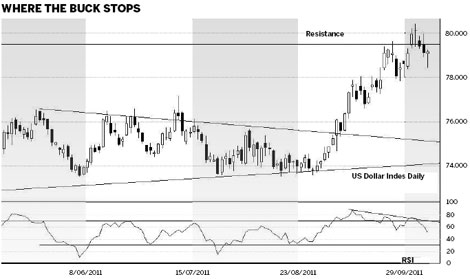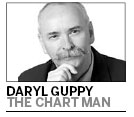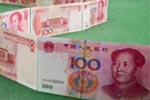Ongoing eurozone crisis gives boost to dollar index
Updated: 2011-10-10 11:53
By Daryl Guppy (China Daily)
|
|||||||||||
The continuing drawn-out crisis in the eurozone has driven up the value of the US Dollar Index. The index is a basket of currencies made up of the euro, the Japanese yen, UK sterling, the Canadian dollar, the Swiss franc and the Swedish krona. It is used as a measure of the strength or weakness of the US dollar.
|
|
The Australian dollar, one of the most traded world currencies, is a market too small to absorb the flight of nervous capital from Europe. The yuan is not yet sufficiently internationalized to absorb these capital flows so investors turn to the US dollar because they have no other realistic choice.
Some have interpreted this US Dollar Index rise as a vote of confidence in the US. Others point to the continued sluggish growth, expanding deficit, political gridlock and the prospect of printing more money as a consequence of the next round of quantitative easing manipulated through the government trading of long-term and short-term bond maturity rates, known as the TWIST strategy.
The rise in the US Dollar Index has added more heat to the current US debate about the value of the yuan. Despite a rise of nearly 7 percent against the US dollar in less than 12 months, and consistent trading near the upper edge of the trading range, the rise in the US dollar index has diminished the effect of this steady and cautious yuan appreciation. The gradual increase in the renminbi is negated by the accelerating weakness in the US dollar.
The key question for currency traders and exporters revolves around the sustainability of this rise in the US Dollar Index. The index chart has several features that help answer the question.
The weekly chart shows the development of a symmetrical triangle pattern. This is a pattern of indecision. The market is waiting for a new development - in this case the progress on the resolution of Greek and eurozone debt. When the price breaks out of this pattern the breakout is often very rapid. The recently announced eurozone solutions drove funds out of euros and into US dollars. The result was a rapid breakout on the upside.
The depth of the symmetrical triangle is measured and used to calculate the potential upside target. This is located at $0.795. This is also the lower edge of a long-term support and resistance level. A move above this level has the next resistance level near $0.815. This creates a narrow consolidation band.
The price breakout from $0.745 very rapidly reached the first target near $0.795. Now the market is developing a consolidation pattern near the lower edge of the trading band between $0.795 and $0.815. The fast momentum has disappeared from the US Dollar Index breakout.
This is also confirmed with the development of a relative strength indicator (RSI) divergence pattern. The RSI divergence is shown when its trend line peak highs move in the opposite direction to the trend line on the peak highs for the US Dollar Index price chart. This indicator does not tell when the upward trend rally will end, but it is very useful for recognizing the conditions that lead to a trend reversal. This divergence pattern suggests there is an increasing probability the rally in the US Dollar Index has ended and that a new downward trend will develop.
The downside targets for the US Dollar Index are again based on support and resistance calculations. A fall from $0.795 has the next well-defined support level near $0.745.
A weakening of the US Dollar Index has bullish implications for gold, with the potential for a rebound from the 2011 upward trend line currently near $1,600. A weak US dollar will again put pressure on other currencies including the Japanese yen, the Korean won and the Australian dollar.
The currency markets are subject to the same extreme levels of volatility that are plaguing equity market indexes including the Dow, the FTSE and the DAX.
The author is a well-known international financial technical analysis expert.

Related Stories
Experts urge caution in Eurozone aid bids 2011-09-24 13:53
- Coming soon: Cell phones that do it all
- Car rentals switch up several gears
- Sinopec to buy Canada's Daylight for $2b
- 'Crash' train line back to normal
- China IPOs shrink 40% in Jan-Sept amid bear market
- Xinjiang gets more support in policy
- Rules tightened over banks' products
- Agriculture faces a growing problem














